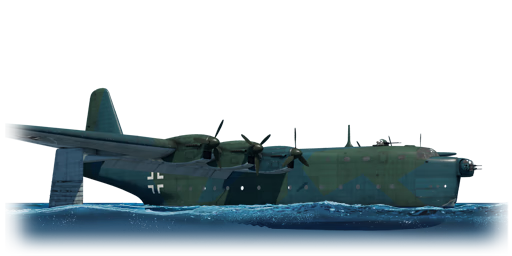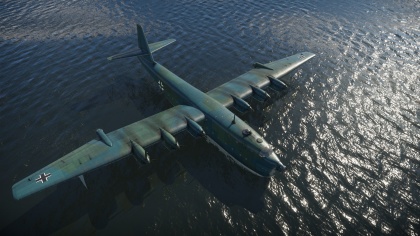BV 238
Contents
Description
The BV 238 is a Rank German heavy bomber
with a battle rating of (AB), (RB), and (SB). It was introduced in Update 1.63 "Desert Hunters".
General info
Flight Performance
The BV 238, as expected of an aircraft of its size and class, is a very sluggish plane. With slow acceleration, poor climb rate, agonisingly slow roll rate, a low top speed, and a pitiful turn rate, the BV 238 will not find itself able to out-perform anything it faces. While using combat flaps, the bomber's turn rate does increase significantly, but it will still not be able to out-manoeuvre any plane it finds itself near. The only notably good flight characteristic of the BV 238 is the low stall speed, allowing it to glide long distances at low speeds as well as allowing the plane to enjoy incredibly slow and smooth landings.
| Characteristics | |||||||
|---|---|---|---|---|---|---|---|
| Stock | |||||||
| Max Speed (km/h at ?,000 m) |
Max altitude (meters) |
Turn time (seconds) |
Rate of climb (meters/second) |
Take-off run (meters) | |||
| AB | RB | AB | RB | AB | RB | ||
| 401 | 390 | 31.4 | 33.2 | 1.6 | 1.6 | 3000 | |
| Upgraded | |||||||
| Max Speed (km/h at ?,000 m) |
Max altitude (meters) | Turn time (seconds) | Rate of climb (meters/second) |
Take-off run (meters) | |||
| AB | RB | AB | RB | AB | RB | ||
| 443 | 421 | 28.7 | 30.0 | 4.6 | 3 | 3000 | |
Details
| Features | ||||
|---|---|---|---|---|
| Combat flap | Take-off flap | Landing flap | Air brakes | Arrestor gear |
| ✓ | ✓ | ✓ | X | X |
| Limits | ||||
|---|---|---|---|---|
| Wing-break speed (km/h) |
Gear limit (km/h) |
Combat flap (km/h) |
Max Static G | |
| + | - | |||
| ??? | ~?? | ~? | ||
| Optimal velocities | |||
|---|---|---|---|
| Ailerons (km/h) |
Rudder (km/h) |
Elevators (km/h) |
Radiator (km/h) |
| < ??? | < ??? | < ??? | > ??? |
| Compressor (RB/SB) | ||
|---|---|---|
| Setting 1 | ||
| Optimal altitude | 100% Engine power | WEP Engine power |
| ?,??? m | ??? hp | ?,??? hp |
Survivability and armour
- 5 mm Steel plate behind pilot.
Though the BV 238 almost entire lacks armour, it is a highly survivable plane. Massive areas of empty space within the fuselage as well as the iconic six engines of this behemoth cause the bomber to be an incredibly tough target to take down. With smart use of Manual Engine Controls to disable engines and manipulate radiators, a BV 238 pilot can nurse even a critically damaged bomber several kilometers home safely. Due to the plane's role as a flying boat, the belly of the bomber is unusually durable, and can easily survive landings on land-based runways in spite of the BV 238's lack of a wheeled landing gear.
In terms of crew, the BV 238 houses an impressive ten crew members, with two crew members in the flight deck and five more each manning various gunner positions around the aircraft, and three more micellaneous crew. This makes the BV 238 very hard to neuter, as the crew members are spaced very far apart, with one gunner on each wing past the third engine, two near the flight deck, and one in the tail of the aircraft, all together making it nigh-impossible to prevent return fire from the bomber.
Armaments
Suspended armament
The BV 238 can be outfitted with the following ordnance:
- 20 x 250 kg SC250 bombs
With only one ordnance option, the BV 238 does not spoil the pilot with choice. However, this bombload is exceptional for the BV 238's battle rating, allowing a single bomber to destroy three bombing points with no allied aid. The BV 238's bombload is entirely contained within a bombbay located within the belly of the aircraft, which must be opened prior to ordnance drop.
Defensive armament
The BV 238 is equipped with an excellent selection of defensive positions. On the roof of the aircraft sits a deadly dual-20 mm turret, containing two MG 151 cannons that are capable of inflicting critical damage to aircraft with few hits. This turret mainly covers the port and starboard sides of the boat, as well as directly in front of the nose, with the BV 238's massive tail section blocking a considerable amount of the turret's rear view. To cover for this blindspot, the BV 238 also has three rear facing turrets each equipped with quad MG 131 13 mm machine guns, with high firerates and large ammo counts for sustained fire. As a bonus, the bomber also has an additional quad MG 131 turret within the nose.
Unlike most bombers, and especially unlike those comparable in battle rating to it, the BV 238 is very well defended, which combines with the plane's excellent survivability to make the bomber into an incredible lethal platform, in spite of the plane's extremely poor flight performance. There are very few blind spots not a single gunner can reach, and those that end up on the tail of the BV 238 can potentially end up facing down not only twelve 13 mm machine guns, but also two 20 mm cannons.
Usage in battles
Though slightly unusual in design, the BV 238 is a strategic bomber through and through. It carries a massive bombload allowing the bomber to decimate several bombing points and deliver more ordnance yet to the enemy airfield, has incredible endurance allowing it to stay airborne far longer than most other aircraft could and through far more damage than its contemporaries could bear.
The BV 238's main job in battle will be to deliver its payload to the strategic objectives found around the map, and has a secondary use as a gunship with its impressive 'defensive' armament. BV 238 pilots should seek to bait enemy fighters, who typically have poor high altitude performance at the BV 238's battle rating, into following the behemoth before mowing them down with an unrelenting and lethal cloud of lead.
BV 238 pilots should avoid head-ons where possible; the only true way to guarentee an easy kill on a BV 238 is to instantly knock the pilot out, thus causing an immediate target destruction. However, in the event of an unavoidable head-on, manually man the forward turrets and unleash fire and fury on whoever is attempting to bring you down; you have plenty of ammo to spare.
Manual Engine Control
| MEC elements | ||||||
|---|---|---|---|---|---|---|
| Mixer | Pitch | Radiator | Supercharger | Turbocharger | ||
| Oil | Water | Type | ||||
| Controllable | Not controllable | Not controllable | Not controllable | Separate | Not controllable | Not controllable |
Modules
| Tier | Flight performance | Survivability | Weaponry | ||
|---|---|---|---|---|---|
| I | Fuselage Repair | Radiator | |||
| II | Compressor | Airframe | |||
| III | Wings Repair | Engine | |||
| IV | Engine Injection | Cover | |||
- As a premium aircraft, the BV 238's modifications are automatically unlocked upon purchase of the aircraft.
Pros and cons
Pros:
- Impressive bomb load (2.5 tons of TNT over 20 bombs)
- Extremely durable airframe, with a large number of crew
- Excellent defensive armament in most-all directions
- Ability to land on water, and rearm/repair from nearby carriers
Cons:
- The largest aircraft in War Thunder, thus an easy target
- Exceptionally poor flight characteristics
- No access to a landing gear, must belly land or land on water
History
The Blohm and Voss BV 238 was an experimental flying boat that saw development and flight trials in 1944. With a wing span of just over 60 metres, and a length of 43.5 metres, the BV 238 was a truly gargantuan aircraft, being in fact the heaviest aircraft in existance at the time. Powered by six DB.603V 12-cylinder radial engines, the BV 238 could reach 424km/h at 6 kilometres altitude, with a range of over 10 000 kilometres.[1]
However, the BV 238 prototype met an unfortunate end before it could reach production, meeting its end at the hands of Allied Fighters early in its life.[2]
Media
Excellent additions to the article would be video guides, screenshots from the game, and photos.
See also
Links to the articles on the War Thunder Wiki that you think will be useful for the reader, for example:
- reference to the series of the aircraft;
- links to approximate analogues of other nations and research trees.
External links
[Development] BV 238: The Largest Aircraft
| Germany bombers | |
|---|---|
| Arado | Ar 196 A-3 |
| Blohm & Voss | BV 138 C-1 · BV 238 |
| Dornier | Do 17 E-1 · Do 17 Z-2 · Do 217 E-2 · Do 217 E-4 · Do 217 K-1 · Do 217 M-1 |
| Focke-Wulf | Fw 189 A-1 · Fw 200 C-1 |
| Henschel | Hs 123 A-1 |
| Heinkel | He 111 H-3 · He 111 H-6 · He 111 H-16 · He 115 C-1 · He 177 A-3 · He 177 A-5 |
| Junkers | Ju 87 B-2 · Ju 87 R-2 · Ju 87 R-2 Libya · Ju 87 D-3 · Ju 87 D-5 · Ju 88 A-1 · Ju 88 A-4 · Ju 188 A-2 · Ju 288 C |
| Messerschmitt | Me 264 |
| Savoia-Marchetti | ▀S.M.79 serie 1 · ▀S.M.79 B · ▀S.M.79 serie 4 · ▀S.M.79 serie 8 |
| ▀S.M.79 AS · ▀S.M.79 bis/N · ▀S.M.79 bis/T.M | |
| Trophies | ▀Wellington Mk Ic |





